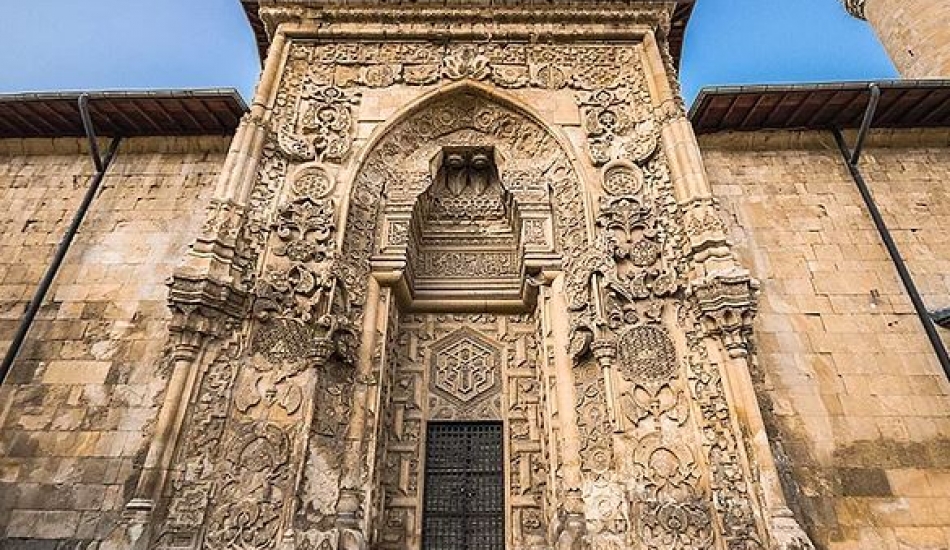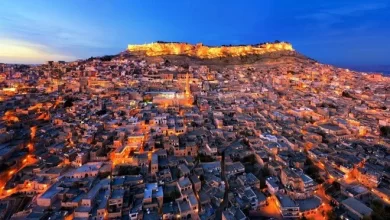Divrigi Great Mosque and Darussifa, Sivas

Divrigi Great Mosque and Darussifa is a complex consisting of this complex, mosque, Darussifa and tomb. It was built together with the Mengucek Principality of the Anatolian Seljuk State. The Great Mosque was built by Ahmet Shah, the son of Suleyman Shah; The Darussifa was built by Melike Turan Melek. The Chief Architect of the building, which was started in 1228 and completed in 1243, is Ahlatlı Hurrem Shah, son of Mughis.

All the motifs, especially the productions and columns, are elements of interest and design, showing the rarest and most beautiful examples of Ahlat and Tbilisi masters found in many parts of the complex. This study has a distinctive and unique feature in that it talks about the system system and that no area repeats itself in the decorations, which are geosymmetrical in their solutions; It is a magnificent harmony in the universe and it is engraved and revealed in the stone passing through the forest. Architectural style, decorations and scenes are planned and gain importance with harmony. This masterpiece is in the real design design in the world. This will be the purpose of the lessons in the study. This magnificent monumental work, which amazes those who see it, was designed by art originals with expressions such as “Divrigi miracles”, “Alhambra of Anatolia”. This “World Cultural Heritage” Islam, which was a “masterpiece” by UNESCO in 1985, is also the name of T.C. Protection of the office of the President.
Sivas Divrigi Great Mosque
Ulu Mosque has a rectangular plan in the north-south direction and is entirely made of cut stone. There are three separate monumental gates in the north, west and east directions that provide entrance and exit to the mosque. The interior is divided into twenty-five units of varying widths with double-sided pointed arches connecting the octagonal columns. The front of the great mihrab is sliced and the middle part is covered with oval domes. The dome of the middle section with octagonal lighting lanterns is covered with an octagonal pyramidal cone. Star, plus and compound vaults formed the cover system of other units. The Shah mahfili in the southeast also draws attention with its compound vault cover. The interior of the mosque contains simplicity compared to the doors. It is possible to say that simplicity is preferred in order not to distract the worshipers and not to disturb the awe and peace in worship. The columns on the woven door side of the mosque are those that were strengthened by Mimar Sinan during the reign of Suleiman the Magnificent. The thin columns next to the king’s gate are original. In the interior of the mosque, behind the gate of heaven, there are two trust chests carved from a single piece of stone. When people go to a place, they leave their valuables and ornaments in a safe, and when they return, they find it as they left it. There is also a charity stone. Benevolent people would leave their alms inside this stone, and those in need would take as much as they needed. This practice is the reflection of a sensitivity based on not harming the poor and protecting their dignity, which is expressed as “what one hand gives, the other does not know”.

There is a spear and torch motif painted with iron oxide paint on the left side of the back of the gate of heaven. The spear represents power and the torch represents knowledge. The stalactites on the vault above the sky gate have the appearance of tears. The window opening to the tombs on the left side of the mihrab in the hospital provides the connection between the mosque and the tomb. In the northwest corner of the mosque, there is a cylindrical minaret with a single balcony. It is stated in the inscription that the minaret was built by the Ottoman Sultan Suleiman the Magnificent in 1565. It is known that the interior of the mosque was also repaired during this period.
West Gate
Although the name of this door, which has been widely used recently, is “Textile Door”, there are also names such as Çarşı Door, Exit Door, and Shadowy Door. The most striking element on the door is the protruding keystone. There is a bunker head motif symbolizing blacksmiths on its surface. The lead architect used the keystone method, which is the way the stones interlock and hold each other. In the middle are tulip and tulip petals. Tulip motifs are very popular in this work. In Sufism, the tulip represents God because the tulip grows from a single bulb as a single plant and signifies unity. At the same time, the word Allah and the word tulip correspond to the same numerical value (66) in the abjad calculation. The inscription on the three-line inscription above the door is as follows: “The helpless servant in need of Allah’s forgiveness, the just sultan, Ahmet Shah, son of Süleyman Shah, son of Şehinşah, ordered this to be done. 626 (M. .1228), may Allah perpetuate his property” . The columns on the right and left inside the door are the balance columns. The word Allah is written horizontally with the original Arabic text in the scale column on the right, and the word Allah is written at an angle in the left column. These columns were rotating in the direction of the arrow signs on them until the 1939 Erzincan earthquake. Between May and September, 45 minutes before the afternoon prayer, a shadow in the form of a human silhouette forms at the west gate. This silhouette takes the form of the shadow of a person who recites the Qur’an first and stands up by tying his hands when the time for prayer approaches. It is stated by experts that these silhouettes on this door and other doors are not a coincidence, and that they can be made with a very comprehensive knowledge of physics and very fine calculations. still not fully resolved.

Outside the door, there is a double-headed eagle on the right, a double-headed eagle and a bowed hawk on the left. The double-headed eagle is an emblem symbolizing the Anatolian Seljuks. It represents power, nobility and freedom. The bowed hawk is the symbol of the Mengucek Principality. A falcon figure was carved on the stone to show the loyalty and respect of the Mengucek Principality to the Anatolian Seljuk state. At the same time, one claw of the hawk is in the air. This is an indication that the principality can show its strength against injustice and injustice.
Heaven Door
Although each door has its own beauty in this work, the most magnificent and most magnificent is this door. Although the gate is known as the Castle Gate because it faces the castle, the North Gate because it faces the north, and the Cümle Door because it is used as the entrance gate of the congregation, the most known and used name is Heaven Door. The reason why this gate is called the gate of heaven is due to the fact that all the motifs on it depict heaven. In the verses describing Paradise in the Qur’an, the descriptions of the unique blessings of Paradise are engraved on stones here. When wanted to be told, the motifs that describe it were just as wonderful and unique. The whole gate is likened to the garden of paradise, and heaven and its layers are explained. The phrase “May the happiness, reign and happiness of the just sultan be eternal” on the star border on the right and the text of the part of Ayetu’l-Kursi that means “There is no god but Allah, there is no god”. “. There is no god but Allah.” It is written. It is written with the symmetry of “He is alone”. During the reign of Deputy Caliph Alaeddin Keykubat, “Sultanu’l-Muazzama” is written on the inscription above. Sultan Alaeddin Keykubat glorified him, especially at the gate of Paradise, by putting the sultan’s name on his head.

Sah Door
This door, located in the eastern part of the mosque, has a modest appearance made in the classical Seljuk style. It is the gateway to the remaining part of the mosque skeleton used by the Shah to enter the mosque for worship. It serves the same function as the gates called “Hunkar Door” in the Ottoman Empire. The purpose of making the door smaller than human height is to reveal the consciousness of humility and servitude in people and to emphasize that the Shah will only prostrate to Allah. The sultan’s gates and temples were built not to isolate the sultan or the aghas from the congregation, but to protect them against possible assassinations and attacks. On the inscription above the door, the phrase “The property belongs to Allah and only Allah” is written, as if to remind the Shah of the owner of the immovable every time he enters the mosque.
Darussifa
In the past, names such as hospital, bimarhane, hospital were used for buildings that serve as hospitals today. Divrigi Darussifa is one of the oldest and most important hospitals in Anatolia. The hospital was also used as a madrasah where positive and religious sciences were taught during the Ottoman period. The Sifahane, which was built in accordance with the Central Asian Turkish building tradition, has a rectangular plan in the east-west direction. The work made of cut stone has a covered courtyard, three iwans, and the west wing has two floors. The most prominent cover system is the star vault of the main iwan. Cradle, pointed, mirrored, cross, plus and star vaults were also used in the building. Its courtyard is divided into nine cross-shaped sections with double-sided arches on ornate columns. The top of the middle section is covered with a glazed iron joinery cone, where the barrel vault arms on both sides meet with the cornerstone and octagonal pulley in the middle.







